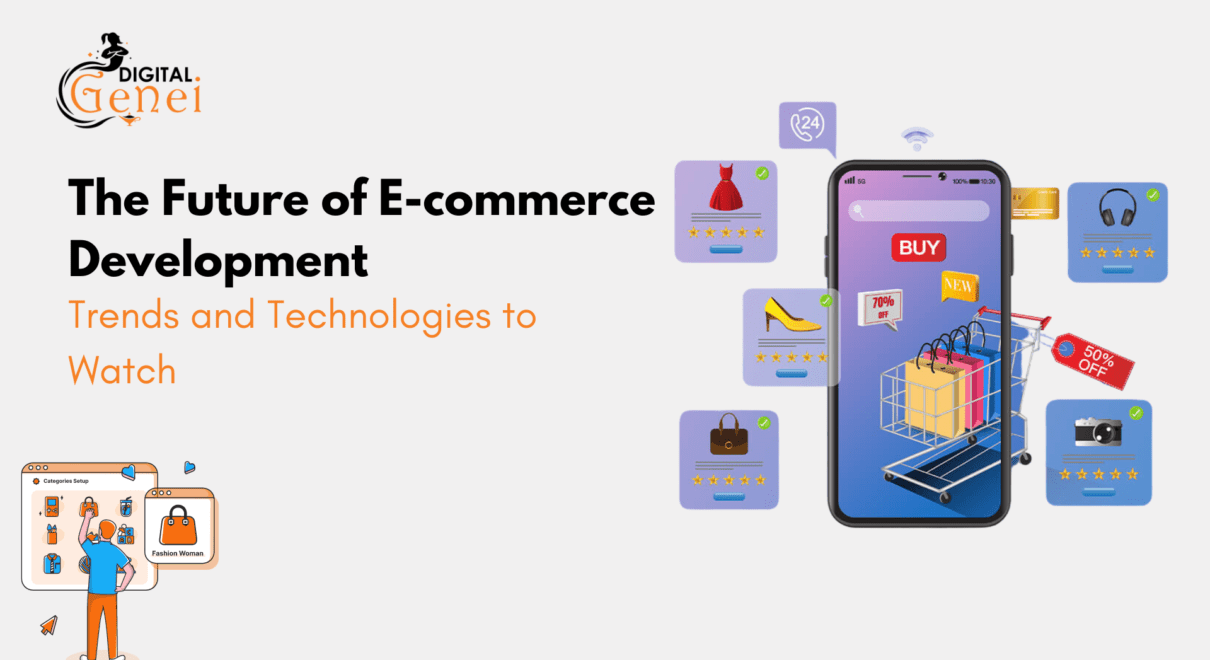The dynamic field of e-commerce has completely transformed the way we shop and do business. Technology is advancing quickly, and customer preferences are shifting. To stay competitive, your company needs to stay on top of these developments. Businesses must identify and take advantage of the trends that will shape the future of online trading as 2024 comes near.
Let’s look at the key trends that will change the e-commerce experience in the following year. Here are some trends that are driving the present and shaping the future of e-commerce.
1. AI-Powered Personalization
The e-commerce user experience is about to change because of artificial intelligence (AI). In the fast-paced world of digital commerce, artificial intelligence will offer each customer a seamless, highly personalized experience in 2024, encouraging brand loyalty and satisfaction among consumers.
Chatbots powered by AI are getting more and more intelligent; offering immediate customer service and individualized product recommendations. These virtual shopping assistants may greatly improve clients’ shopping experiences by assisting them in navigating your website, providing answers to their concerns, and directing them to the appropriate products.
2. Augmented Reality (AR) & Virtual Reality (VR)
Customers’ experiences with products and decision-making processes are being revolutionized by the e-commerce technology trends of augmented reality (AR) and virtual reality (VR). These innovations bridge the gap between online and offline purchasing by giving consumers genuine, engaging experiences.
AR overlays digital information onto the real world, enhancing the shopping experience by allowing customers to visualize products in their environment.
VR, on the other hand, creates a simulated environment that users can immerse themselves in, providing a virtual shopping experience.
3. Voice Commerce Evolution:
Voice assistants and smart devices are used in voice commerce, or “v-commerce,” an expanding trend in eCommerce technology that allows users to make purchases with speech commands. Voice commerce has become increasingly popular with the emergence of virtual assistants such as Microsoft’s Cortana, Apple’s Siri, Google Assistant, and Amazon’s Alexa. It is changing how consumers engage with brands and make purchases online.
The main reason voice commerce is becoming more popular is that it provides a more practical and easy-to-use shopping experience. Voice commands allow consumers to connect with online platforms naturally and straightforwardly.
The hands-free operation of voice commerce enables users to perform tasks and make purchases without manual input, making it particularly appealing in various situations.
4. Mobile Commerce & Progressive Web Apps (PWAs)
The purchasing and selling of goods and services using mobile devices, like tablets and smartphones, is known as mobile commerce, or m-commerce. The simplicity and growing popularity of mobile devices have made m-commerce a major force behind the expansion of e-commerce. Businesses are implementing Progressive Web Apps (PWAs) to serve mobile users.
PWAs are web apps that give users on mobile devices an experience similar to that of native apps. They provide a smooth and responsive user experience by fusing the functionality and performance of native apps with the flexibility of the web.
5. Omnichannel Marketing
The omnichannel marketing strategy is also becoming more popular. Knowing the distinction between multi-channel and omni-channel marketing is essential.
The goal of omnichannel marketing is to create a more structured and improved customer experience. It guarantees that clients receive the same communication through all available channels. It synchronizes all digital channels with physical stores and with each other. Customers receive the same flawless experience whether they are browsing the products on the official website, social media pages, or in-person at the brick-and-mortar store. For example, some businesses even display online reviews of the product in the gallery of the brick-and-mortar store.
6. Multiple Payment & Collection Options
Enhancing the flexibility and ease of eCommerce transactions requires a variety of payment and collection options. Giving customers more options for payment and collection provides them with more control over their purchasing experience.
Popular payment methods in eCommerce include:
Credit and debit cards: Customers can use their Visa, Mastercard, American Express, or other major credit and debit cards to make purchases using this method, which is still the most popular one.
Bank transfers: Some clients prefer to utilize bank transfer methods to make payments directly from their bank accounts. Customers using this technique must approve the money transfer from their bank to the merchant’s account.
Digital wallets: Digital wallet services, such as PayPal, Apple Pay, Google Pay, and Amazon Pay, offer users a simple and safe way to save their credit card details and make transactions online.
Cryptocurrencies: Due to the popularity of cryptocurrencies like Bitcoin, Ethereum, and Litecoin, digital currencies are now accepted as payment on certain eCommerce sites. Transactions with cryptocurrencies provide privacy, security, and decentralization.
Prepaid cards: Customers can easily make purchases online using prepaid cards or virtual gift cards without using their own credit or debit cards. These cards have a set amount preloaded on them, and you can make purchases with them up until the balance runs out.
In addition to payment options, providing multiple collection options is equally important. The option of home delivery is frequently chosen, particularly for larger items or clients that prioritize convenience.
7. Q commerce
Q-commerce, also called Quick commerce. Quick commerce is the next step in the evolution of eCommerce and as the name suggests it’s all about speed. Quick commerce generally means consumers can expect delivery within one hour of placing an order.
Referred to interchangeably with “on-demand delivery” and considered the third generation of trade, it tends to focus on smaller quantities of goods, such as groceries, medications, and other everyday essentials and staple items, like toiletries.
This rapid delivery model is driven by consumer demand for instant gratification and convenience. Technologies such as real-time inventory management, micro-fulfillment centers, and smart delivery systems are critical to enabling q-commerce. As this trend continues to grow, businesses will need to adapt their logistics and operational strategies to meet the high expectations of Q-commerce consumers.
Conclusion:
E-commerce has a bright future for companies ready to adapt and take advantage of new trends and technologies. E-commerce companies need to stay ahead of the curve by embracing these trends and investing in the tools and tactics that will spur growth and consumer happiness as AI, AR/VR, voice commerce, and other breakthroughs continue to transform the sector. Online retailers should position themselves for success and growth in a market that is becoming more and more competitive by comprehending and applying the top e-commerce trends of 2024.





